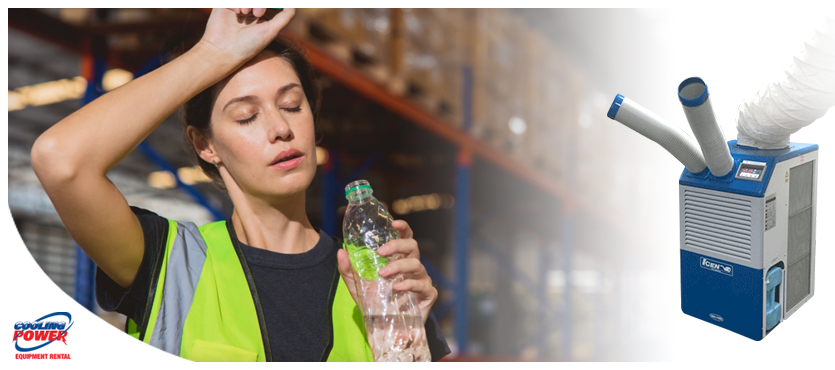When it comes to managing indoor temperatures in commercial and industrial spaces, not all cooling solutions work the same way. Two of the most commonly used temporary cooling options are spot cooling and portable air conditioning units. While they may appear similar at first glance, they serve different purposes, operate in different ways, and are best suited for different environments. Understanding the difference between the two can help businesses choose the right solution for their specific needs, whether it is for employee comfort, equipment protection, or operational continuity.
What Is Spot Cooling?
Spot cooling is a targeted cooling method designed to direct cold air to a specific area, piece of equipment, or workstation. Instead of cooling an entire room or facility, spot cooling focuses on a smaller zone where heat buildup is most intense. This makes it highly efficient in environments where only certain areas need cooling or where localized heat is being generated by machinery, electronics, or high-activity workstations.
Spot coolers are commonly used in data centers, server rooms, manufacturing floors, and warehouses. For example, a data center may have an overall HVAC system, but certain racks generate more heat than others. A spot cooler can be positioned to blow cold air directly onto those hotspots to prevent overheating. In industrial settings, machines that run continuously can raise temperatures in specific areas, making spot cooling ideal for protecting equipment and keeping workers comfortable.
Because spot cooling is directional and focused, it uses energy more efficiently and avoids the cost of cooling large spaces unnecessarily.
What Are Portable AC Units?
Portable air conditioning units are designed to cool larger areas rather than just a specific spot. These units work similarly to standard AC systems by drawing in warm air, cooling it through a refrigerant cycle, and then distributing the cooled air throughout the space. They generally include a hose to exhaust warm air outside or into another area.
Portable AC units are commonly used in offices, temporary facilities, event tents, classrooms, retail spaces, and areas where the primary HVAC system is insufficient or undergoing maintenance. For example, an office experiencing an HVAC failure can use portable AC units to keep an entire room or floor comfortable. At events like trade shows or outdoor gatherings under tents, portable AC units can cool larger enclosed spaces to ensure guests and staff remain comfortable.
These units are effective when broad, even cooling is needed rather than targeted airflow. They can also help maintain indoor air quality and humidity levels in environments where comfort and climate control are important.
Key Differences Between Spot Cooling and Portable AC
The biggest difference between the two systems is coverage. Spot cooling is focused and intensive, while portable AC units are designed for general area cooling. Spot coolers are often placed close to equipment or workers, delivering high volumes of cold air exactly where needed. Portable AC units, on the other hand, circulate air more evenly to cool an entire room.
Another major difference is energy usage. Spot cooling is typically more energy-efficient because it cools only what is necessary. Portable AC units may require more power since they are conditioning larger spaces. However, in environments like offices or event spaces where overall comfort matters, portable AC units are the better fit.
Installation and portability also differ. Spot coolers often come with flexible ducts that allow precise airflow direction, while portable AC units typically use exhaust hoses and require access to windows, vents, or doorways to expel hot air. Spot coolers are ideal for environments where structural access is limited or where equipment cooling is critical. Portable AC units are more suitable for finished spaces or temporary enclosed environments.
Choosing the Right Solution
Selecting between spot cooling and portable AC depends on several factors, including the size of the space, the heat source, the number of people in the area, and the purpose of cooling. If only a small area or specific equipment needs cooling, spot cooling is the most efficient and cost-effective choice. If comfort across an entire room or zone is the priority, portable AC units are the better solution.
In many cases, facilities use both. For example, a manufacturing plant might use portable AC units to reduce overall ambient temperature while using spot coolers to protect high-heat machinery. A data center might rely on portable cooling for general climate control and place spot coolers near server racks to handle hotspots.
Understanding your facility’s layout, heat patterns, and operational needs will help determine the most effective approach.
Matching Cooling Solutions to Real Needs
Spot cooling and portable AC units both play important roles in maintaining temperature control, but they serve different purposes. Spot cooling delivers precise, targeted airflow to protect equipment and specific work zones, while portable AC units provide broader comfort by cooling larger areas evenly. Choosing the right solution can improve energy efficiency, protect assets, and maintain productivity.
Cooling Power Corp offers both spot cooling and portable AC rentals to meet the unique needs of industrial, commercial, and temporary environments. To find the best cooling solution for your facility, visit Cooling Power Corp’s contact page.

